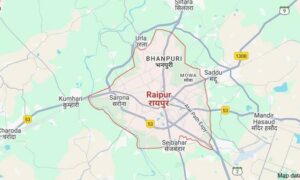
Delhi’s Air Quality Index reached 373 on Sunday afternoon, placing it in the “very poor” category, with 15 monitoring stations recording “severe” levels above 400.
The 15 stations are Ashok Vihar, Bawana, Burari, Chandni Chowk, Mathura Road, Dwarka, Nehru Nagar, Okhla, Punjabi Bagh, Pusa, RK Puram, Rohini, Siri Fort, Vivek Vihar and Wazirpur, according to data from the Sameer application, which provides hourly updates published by the Central Pollution Control Board.
The city continued to be covered in dense winter smog, reducing visibility, while temperatures hovered around 20.6 degrees Celsius, the Central Pollution Control Board said.
The Central government’s Air Quality Early Warning System forecast that pollution levels would remain “very poor” until at least Tuesday, Deccan Herald reported.
The national capital had reported an AQI of 303 on Saturday, up from 218 a day earlier.
An index value between 0 and 50 indicates “good” air quality, between 51 and 100 indicates “satisfactory” air quality and between 101 and 200 indicates “moderate” air quality. As the index value increases further, air quality deteriorates. A value of 201 and 300 means “poor” air quality, while between 301 and 400 indicates “very poor” air.
Between 401 and 450 indicates “severe” air pollution, while anything above the 450 threshold is termed “severe plus”.
Air quality deteriorates sharply in the winter months in Delhi, which is often ranked the world’s most polluted capital. Stubble burning in Punjab and Haryana, along with the lighting of firecrackers, vehicular pollution, falling temperatures, decreased wind speeds and emissions from industries and coal-fired plants contribute to the problem.
On Saturday, as pollution worsened, Delhi began enforcing a ban on the entry of commercial goods vehicles, except those running on CNG, LNG or electricity and compliant with BS-VI norms, The Hindu reported.
The restriction, issued on October 17 by the Commission for Air Quality Management in the National Capital Region and Adjoining Areas, came into effect on November 1.
BS norms, or Bharat Stage Emission Standards, are regulations set by the Indian government to control air pollutants from motor vehicles. The higher the Bharat Stage norm, the stricter the standard and the lower the permissible emissions.
Congress calls Delhi cloud seeding experiment ‘cruel joke’
The Congress on Sunday criticised the Delhi government’s Rs 34-crore winter cloud-seeding experiment, calling it a “cruel joke”.
Party leader Jairam Ramesh said that the experiment went against expert advice from several government agencies.
In a social media post, he cited a December 5, response in the Rajya Sabha by the Union Minister of State for Environment, Forests and Climate Change, which said that three specialised agencies – the Commission for Air Quality Management, the Central Pollution Control Board and the India Meteorological Department – had all advised against using winter cloud seeding to improve Delhi’s air quality.
Ramesh also referred to a detailed report released on October 31, 2025, by the Centre for Atmospheric Sciences at IIT Delhi, which stated that cloud seeding would not help improve Delhi’s air quality.
“Getting slight improvement in a limited area for a day or two, as is now being claimed, is really a cruel joke,” Ramesh said on social media.
The Bharatiya Janata Party government in Delhi, as a part of its air quality management strategy, attempted cloud seeding earlier in the week.
Cloud seeding is the process of combining chemical agents, including silver iodide, dry ice and even common table salt, to condense clouds and increase the chance of rainfall.
Delhi Chief Minister Rekha Gupta said on October 24 that cloud seeding was “a necessity for Delhi”.
The Delhi Govt has spent Rs 34 crore on a winter cloud seeding experiment in order to improve air quality.
On Dec 5, 2024, the Union Minister of State of Environment, Forests, and Climate Change had answered a question in the Rajya Sabha saying that 3 specialised agencies – the… pic.twitter.com/nzu1eFb8xC
— Jairam Ramesh (@Jairam_Ramesh) November 2, 2025
On Tuesday, two cloud-seeding trials were held over northwest Delhi’s Burari, Mayur Vihar and Karol Bagh at 12.13 pm and 3.45 pm. However, no rain was observed in the area.
Another trial on Wednesday was postponed due to a lack of enough moisture in the clouds.
The cloud seeding project has been jointly developed by the Indian Institute of Technology Kanpur and the Delhi government.
On Wednesday, IIT Kanpur Director Manindra Agrawal said that due to the low moisture content of clouds, the chances of inducing rain were very small. Agrawal, however, said that data from 15 monitoring stations after the seeding on Tuesday showed a 6%-10% reduction in PM2.5 and PM10 levels.
Experts have repeatedly pointed out that the experiment is not “very practical” to tackle air pollution as it is expensive, can only cover a limited area and needs very specific meteorological conditions.
They have also said that the respite from pollution through artificial rains is temporary.
Congress MP Priyanka Gandhi Vadra also urged Prime Minister Narendra Modi, Union Environment Minister Bhupender Yadav and Chief Minister Rekha Gupta to take urgent action to address pollution in the capital, saying the city was enveloped in a “grey shroud”.
Returning to the Delhi air from Wayanad first, then Bachwara in Bihar is truly shocking. The pollution enveloping this city is like a grey shroud thrown over it.
It’s really about time all of us get together regardless of our political compulsions and do something about it. The…
— Priyanka Gandhi Vadra (@priyankagandhi) November 2, 2025
Pollution control measures in place
On October 19, the Commission for Air Quality Management had imposed Stage 2 restrictions under the Graded Response Action Plan to control pollution in Delhi and the adjoining areas in the National Capital Region.
The Graded Response Action Plan is a set of incremental anti-pollution measures that are triggered to prevent further worsening of air quality once it reaches a certain threshold in the Delhi-NCR region.
The second stage of the plan involves a ban on the use of coal and firewood, including tandoors in hotels, restaurants and open eateries. It also includes a ban on the use of diesel generator sets, except for emergency and essential services.
It further comprises measures such as the mechanical sweeping of roads and sprinkling water on them to keep the dust from rising, and intensified inspections for strict dust control measures at construction and demolition sites.
The restrictions under Stage 2 include the curbs under the first stage, which was imposed on October 14.
Also read: Delhi’s failure to act against the biggest source of its air pollution – vehicles
📰 Crime Today News is proudly sponsored by DRYFRUIT & CO – A Brand by eFabby Global LLC
Design & Developed by Yes Mom Hosting






